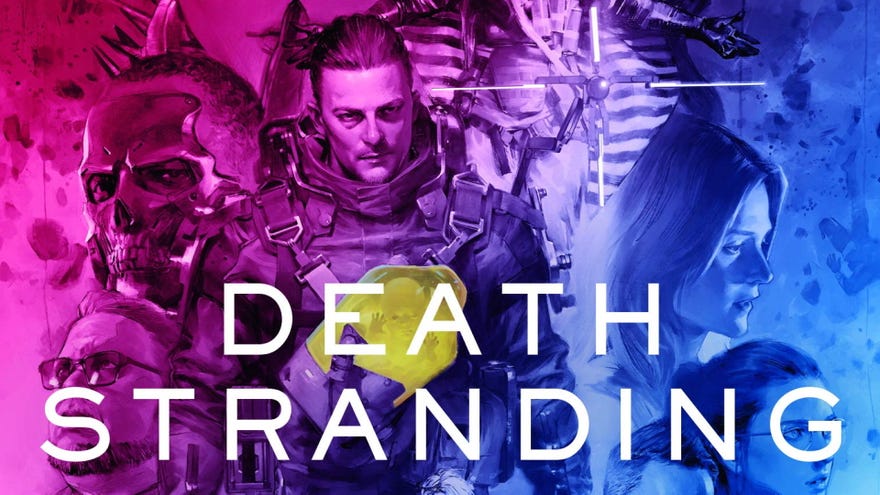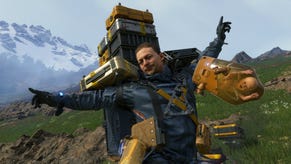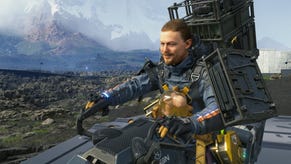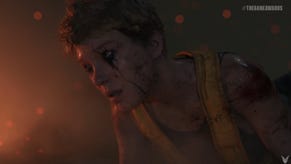We've read the official Death Stranding novels, and they're as weird as the game
Let us walk you through it
Death Stranding was one of my favourite PC games of last year. I spent many a happy hour delivering parcels across the post-apocalyptic hills and mountains of the United States of Icelandic America, and several more chronicling the road trip adventures of the game's main characters in my ten-part BB Boys photo diary. It's a game I have a deep affection for, despite its bonkers plot about nuclear-explosion ghosts, ageing rainfall, and otherworldly jar babies - because why not, goddamnit? - and one that's firmly lodged itself into my brain ever since I saw the final (final final) credits roll at the end of last year. When I heard Titan Books were publishing an official novelisation of the game, I just had to check it out. So I did. Two whole books of it, and lemme tell ya, it's a real kettle of fish.
Written by Hitori Nojima (the pen name of Kenji Yano, who was one of the co-writers on Death Stranding the game along with Hideo Kojima) and translated by Carley Radford, Death Stranding: The Official Novelisation Volumes 1 and 2 follow the game's plot almost to a tee. Dialogue from the game's cutscenes is lifted pretty much word for word, and it also borrows the same character-led chapter structure. As such, the books won't hold any surprises for those of you who have already played the game, and I doubt they'll convert many who haven't.
They do, however, tease out some of the game's subtler themes and metaphors that might have got lost in its rather galaxy-brain storyline, and they also dive much deeper into the thoughts and feelings of the game's supporting cast members. If nothing else, both volumes are fascinating companion pieces to the PC version of Death Stranding, and if you enjoyed the game as much as I did then you'll probably get a kick out of how it's been turned into a book.
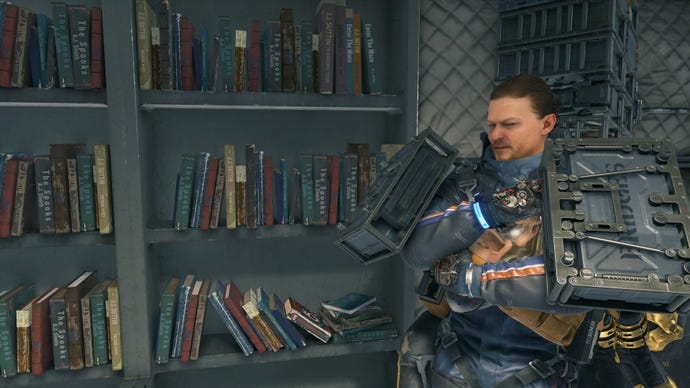
In case you're unfamiliar with the game's story or never made it past its exposition-heavy opening, here's a very quick synopsis. Death Stranding follows the footsteps of a courier named Sam Porter Bridges, who's tasked with rebuilding a kind of country-wide quasi-internet structure known as the Chiral Network, after a series of apocalyptic events have forced the remaining pockets of civilisation underground.
The titular Death Stranding event has made the world above an increasingly dangerous place, bringing with it invisible ghosts called BTs (or Beached Things) causing huge, cataclysmic explosions when they come into contact with the living. Only BBs (or Bridge Babies) can sense these deadly beings, making them valuable tools for porters like Sam who still operate topside while the rest of humanity hunkers down in a series of disparate, isolated bunkers. After his adopted sister Amelie goes missing, Sam must walk the length of America to save her, reconnecting the world's last remaining cities as he goes so he can "make the world whole again" and bring the last remnants of humanity back together.
I like that each book starts with a little cast list and vocabulary section, a bit like a play. This explains exactly what everyone's deal is, as well as what the phrase Death Stranding actually means - which, I'm not gonna lie, took me several hours to figure out when I was playing the game. The game has glossaries and what not hidden away in its various codex pages, sure, but having the key bits of info presented up front like this is something more games should start doing, I think. It definitely would have helped clear up a lot of the early confusion Death Stranding suffers from in its opening hours, and would have probably made those early, jargon-packed cutscenes a lot more palatable. Its overarching story is still pretty out-there stuff, of course, but the vocab list made me feel much better equipped going in than I ever did playing the game.

Death Stranding is by no means a perfect game, of course, and so it's probably no surprise that the books share many of the same flaws. What surprised me most about the Death Stranding novels, though, was how little of the actual game made it into the narrative. The landscape of Death Stranding, which is pretty much a character unto itself in the game, barely gets a look in here, and it's quickly shunted into the background (sorry) once Sam reaches his first stop-off point (the Capital Knot WayStation) on his journey to reconnect America.
"An interesting new wrinkle in the story is Sam's ongoing relationship with his toenails. Yes, toenails."
Indeed, the first (and only) mention of one of Sam's most fundamental traversal tools, the humble climbing hook, comes right toward the end of volume one, and it's not until he's practically half way through book two that he finally gets one of his robotic skeleton leg tools to help him power through the snow drifts up in the mountains. At no point does he ever get on a bike, and the road you spend so long building between the three major cities in the middle section of the game isn't even mentioned. He doesn't even build a single zipline during the course of his journey, which is probably the single thing that brought me the most joy during my own playthrough.
There are surprisingly few encounters with Mules, too, the obsessive delivery men who try to steal Sam's packages throughout the game. There are just two of them, in fact, across the span of both volumes. They're still presented as dangerous outliers who are baying for blood and cargo, but they never feel as threatening as they do in the game. Even the ghostly BTs don't get much air-time here, and they're pretty much the game's biggest menace.
Downplaying these elements makes Sam's whole undertaking feel strangely low-key as a result. The stakes never feel particularly high, and it loses a lot of the peril that defined some of the game's greatest moments for me. It also means you never really see Sam developing much of a relationship with BB, either, as almost every opportunity you had to interact with BB in the game has been removed, be it randomly rocking their jar to soothe them after a nasty BT attack, having a bath in a hotspring and watching them paddle around in their pod all cute-like, using the game's photo mode to create a ten-part photo diary of their roadtrip, or just hearing them giggle with delight as you trip over a rock. It makes Sam's deep mid-to-late story attachment to this jar baby feel like it's come out of nowhere, and on balance, I'd probably say the BB Boys' storyline is one of the weakest overall, as there's just not a whole lot for BB to do apart from snooze away in their jar.
What the novels do bring to the table is a deeper look at Death Stranding's support cast. They fill in the gaps left by the gaping void of all the missing game elements, and there are often whole sections of each chapter that are dedicated to setting up their expanded back stories while they wait for Sam to pitch up on their doorstep. This brought some welcome extra flavour and detail to some of these previously quite two-dimensional characters, and it made the preppers Sam meets (the individual citizens who live in bunkers outside the main cities) feel like they had equal billing to your Deadmans and your Mamas and what not.

Of course, the game has dozens of prepper characters, not all of which make the cut in the books. This means that some of the game's more memorable stories also go unheard in the novelisation, and I'm sad I didn't get to see more of the blossoming love story between the chiral artist and the junkyard man, Conan O'Brien's weird cosplaying otter man, or the charming mountaineer couple who give birth to their first newborn, for example. These omissions also add to the feeling that this world is a much more barren, sterile place than the one in the game, and I almost can't believe I'm about to say this, but I'm not sure that streamlining the story like this actually does the books many favours.
"Death Stranding is by no means a perfect game, so it's probably no surprise that the books share many of the same flaws."
It doesn't help that Sam himself is even more stoic and unreadable here than he is when you're controlling him, either. Even when he's in conversation with other characters, he frequently "couldn't answer", "had no words" or "couldn't quite articulate" what he wanted to say, and heck, sometimes he admits he "didn't know what to say" full stop. I didn't think it was possible to have the book equivalent of an almost silent protagonist, but that's increasingly what it feels like.
Instead, an interesting new wrinkle in the story is Sam's ongoing relationship with his toenails. Yes, toenails. Apologies if the following grosses you out, but early on he ends up ripping one of them off and every time he stops to rest he just won't stop thinking about it. I counted at least five mentions of it in my notes. Nojima gets strangely obsessed with this tiny detail, and it sticks out like a sore thumb (or should that be toe?).
Recurring toenail updates are the least of the novels' worries, though, as Nojima also has a rather bad habit of over-explaining bits of story detail again and again. Dialogue can be quite cyclical at times, and here you feel like the story could have done with a bit of an edit. The game does this as well to an extent, but it somehow feels more oppressive when you're reading great wodges of text. For the most part, though, the game's cutscene dialogue translates well to the page. I said earlier that it's lifted almost word for word, and I know this because you still get lines like how Sam's pal might be called Fragile but "isn't that fragile" in real-life, and how Mads Mikkelsen's character Clifford is "just like any other cliff. A dead end [with] no way forward." The kind of lines that sound clever and ponderous in your head, but are big whopping clangers when they're actually said out loud. The one exception to this rule is Fragile's infamous, "I brought you a metaphor," line, which has mercifully been changed and / or lost in translation to "I've got a delivery for you, Sam."
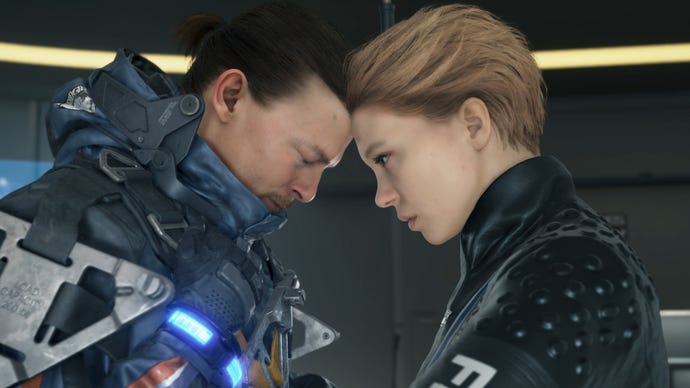
The books haven't lost any of the game's non-existent subtlety, then, but they do manage to draw out some of its more secondary themes and bring them to the fore, shifting the kaleidoscopic lens just enough to shed some new light on overarching narrative. Both Sam and the game's central concept of creating a new America are elevated to almost god-like status in the novelisation, with much more overt religious references and imagery creating an interesting parallel to the self-proclaimed godhood of Higgs, the main antagonist.
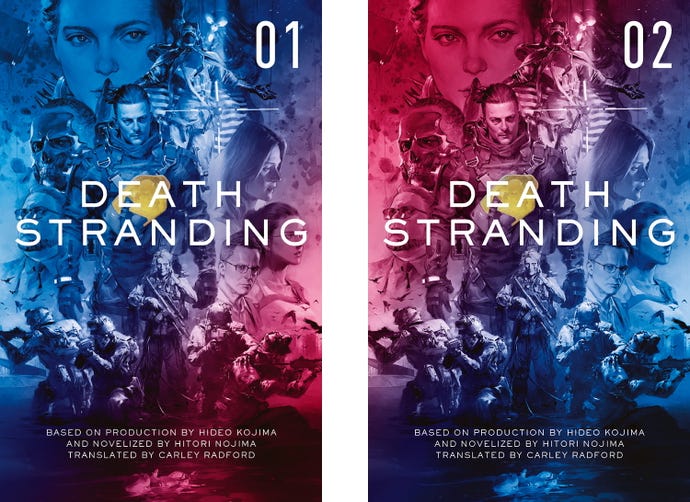
Sam's ability to repatriate / come back to life after a BT void out is also likened to Christ's resurrection, and preppers repeatedly refer to him as a messianic figure who's finally come to save them from their life of solitude and isolation. At one point, you've even got two characters contemplating Da Vinci's Madonna Of The Yarnwinder. It's still not particularly subtle, but the questions the books pose about sacrifice, godliness, origin myths and the lengths we go to in order to save ourselves from extinction are all presented much more thoughtfully here, and they pack a much greater punch as a result. There were hints of this in the game, but they were often buried in the hundreds of codex entries. Here, they've woven much more tightly into the narrative, and it gives you a lot more to chew on while you read.
Because at the end of the day, Sam isn't really the second coming (Nojima's not that indulgent). He's just a bloke trying to do what's right as he struggles to take control of his own destiny, which I think we can all relate to, nuclear ghosts be damned. For all his frustration, pent-up emotions and painful toenails, he still retains that critical everyman trait in the Death Stranding books, and he helps ground the narrative in a way that's digestible and approachable. He's the binding force that pulls these strands together in the books, opens up communication lines and takes us deeper into the world of Death Stranding in a way the game can only dream of, because they're no longer fighting that battle of conflicting mediums of cutscene versus gameplay. They're just pure story, for better or worse. The novels don't fix the flaws of the game, and I think they miss a lot of what makes the game special, but they do make the journey through it a little bit easier.
